
 |
|
|
#1 |
|
Member
Join Date: Dec 2004
Location: Oahu, Hawaii
Posts: 166
|
Always wondered about these terms can anyone give me a quick primer on definitions and how they are different?
|
|
|

|
|
|
#2 |
|
Member
Join Date: Dec 2004
Location: Virginia
Posts: 520
|
Dan
I often use the term inlay as I think that is a more generic term that fits them all. Though I have also heard it used only for times when the pattern was cut and the metal was either glued or hammered into the pattern I have always been told that in niello the pattern was cut out an then filled with a mixture various of silver and lead alloys. this makes the fill black against the metal color 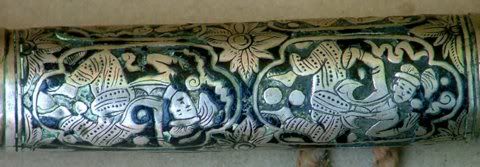 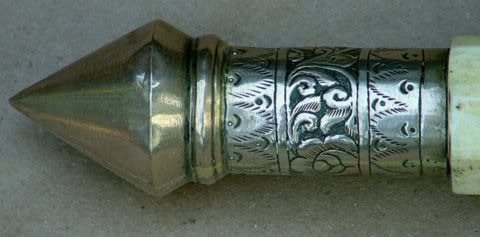 In koftgari lines are etched into the surface then the metal is pressed onto the scratched marks in the shapes needed then it is heated to help it adhere  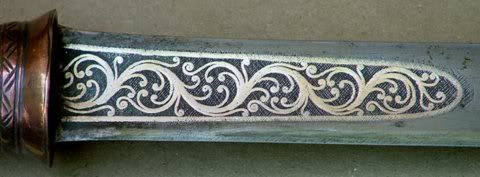 All I could find on chasing describes it as an "embossing" on metal 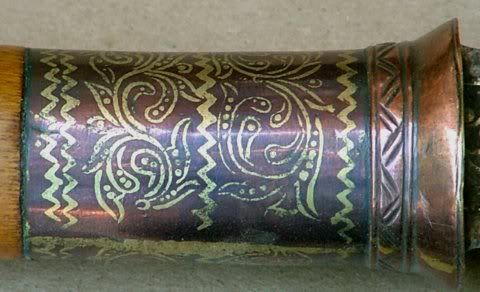 Repousse the metal is hammered into the pattern 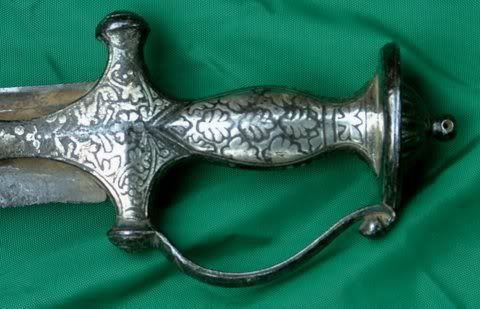 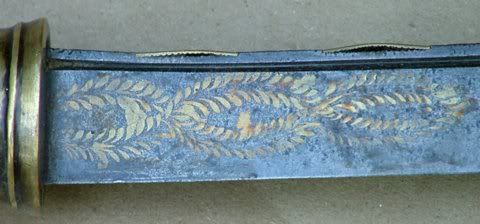 That being said I am not as cautious to use these terms properly as I should be. This my understanding of the terms only and I look forward to comments from those more versed in this than I am John Last edited by RhysMichael; 14th December 2004 at 05:17 PM. |
|
|

|
|
|
#3 |
|
Member
Join Date: Dec 2004
Posts: 987
|
I just checked the dictionary to confirm my recollection about "chased" and "repousee," though as it turns out I had them backwards. "Chased" means a pattern in relief on the surface of the metal, engraved or embossed, but basically by working from the outside in. "Repousse" is relief hammered into the metal from the inside out.
"Embossed" is a more general term that means decoration that is raised above the surface. |
|
|

|
|
|
#4 |
|
Vikingsword Staff
Join Date: Dec 2004
Location: The Aussie Bush
Posts: 4,614
|
Our Forum friend, Battara, is an excellent silversmith and experienced in several of these techniques. I would very much like to hear from him how he uses these terms, and also if he has any pictures to post that illustrate the manner in which the various methods are applied.
Thanks Jose. Ian. |
|
|

|
|
|
#5 |
|
EAAF Staff
Join Date: Dec 2004
Location: Louisville, KY
Posts: 7,363
|
Hi folks. First I want to thank you Ian for your kind feedback. Second, I will try to upload the pictures in the right places:
INLAY: Deep grooves are cut into a harder material (ideally at different angles) and then a softer materal is inserted. For example, on Ian's barong, I had to re-engrave the grooves - cut deeper into the grooves - into the steel. Then I took softer brass wire and hammered it into the grooves. This method of decoration makes the softer metal more permanent and thicker. Often it is then polished down to the level of the harder material. Here is an example of the brass inlay I did on Ian's barong blade: Last edited by Battara; 15th December 2004 at 08:26 AM. |
|
|

|
|
|
#6 |
|
EAAF Staff
Join Date: Dec 2004
Location: Louisville, KY
Posts: 7,363
|
chasing:
Technically, the term "chasing" is named after the process of taking a chasing tool, a straight punch with a straight beveled head in the form of a "v" (point down) and as the artist hammers, the artist moves the tool across the surface in simple straight lines or large archs (there are different ways to do this which I will not get into). What has also been subsumed under "chasing" is the process of hammering soft metals with punches with difrerent shaped heads. The artist would hammer the punches onto the surface of the sheetmetal. These indentations then would start to form a design. Here is the scabbard to a silver headed Sulu kris I made. It was my first attempt at chasing silver: |
|
|

|
|
|
#7 |
|
EAAF Staff
Join Date: Dec 2004
Location: Louisville, KY
Posts: 7,363
|
repoussee:
Repoussee, as correctly identified, is using the same chasing tools, but instead of hammering on top of the sheet metal, it is hammering at first from underneath the sheet metal. This pushes the metal out from underneath, buldging it into forms. After that is done, then the artist flips it onto the other side and chases or hammers from the front to bring crispness and more detail. Here some examples, one of a copper plate, and one of a silver coconut bowl: |
|
|

|
|
|
#8 |
|
EAAF Staff
Join Date: Dec 2004
Location: Louisville, KY
Posts: 7,363
|
neillo:
Neillo is a completely different animal. In use of silver, one may engrave or hollow out the background sections of silver to make the others stand out. In the recessed areas a special lead-sulfer-oxide solution is applied that blackens the recessed areas of the silver. This is more than simple oxidation because it develops a thick plaque of oxidation that lasts longer than just black or brown patina on silver (which enhances value when taken off unlike bronze). This is a very common method used on Russian shaskas and kindjals. It can only be used on silver. Here is a picture of some common Thai jewelry where neillo is used as background as well as on the shaska from Oriental-Arms. Both cases are of course made of silver: Last edited by Battara; 15th December 2004 at 09:47 AM. |
|
|

|
|
|
#9 |
|
EAAF Staff
Join Date: Dec 2004
Location: Louisville, KY
Posts: 7,363
|
koftgari:
Koftgari is a technique that first scars the hard metal, say steel, by incising or cutting lines into the surface. Then the artist takes very thin or flat wire made of soft metal, like silver or gold, and hammers this "tape" onto the cut area. The metal "tape" will be hammered into the incisions and thus will be held in place. It is important to note that these incisions are not as deep and thus the soft metal decoration can wear over time if not careful. Although not as permanent as inlay, the artist can produce more elaborate designs. Most of the examples of koftgari come from 15th-16th century India. Here is an example of heavy silver koftgari on a steel Balinese ceremonial axe (notice the lines on the steel): |
|
|

|
|
|
#10 |
|
EAAF Staff
Join Date: Dec 2004
Location: Louisville, KY
Posts: 7,363
|
If there are any other questions, I would be happy to try my best to answer them
(or just make up the answers  ) )Jose PS: Ian, I love your choice of avatars. 
|
|
|

|
|
|
#11 |
|
Deceased
Join Date: Dec 2004
Location: USA, DEEP SOUTH, GEORGIA, Y'all hear?
Posts: 121
|
Battara
I would like to thank you sir for the great information. You are one in house "google" information center.  You asked but not to me, for any other questions, so if I may I would like to ask a question of my own. I hesitate to do so as it will defiantly show just how low on the learning curve I reside. Anyway I sure would like to see the same type of description that you used for the inlaying ....etc, that is a picture with an explanation, of the main type of Daggers that are posted from time to time on this forum. Sort of a pictorial with description of the "standard" form, again like, what is a PESH KABZ? a KARUD?, KERIS? DHA, etc. I know this is a BIG undertaking and my take several forum folks input (RADU are you reading this?), but the knowledge that you have as well as the others of this forum is outstanding. It just would help me as a new collector, as well as others, I think, to have a thread on this forum where one could go to see what the experts are talking about. I should have started a new thread to ask this question but wilked aka Khun Deng question was so great it got me thinking about my question. Thanks again for the information. Last edited by Mare Rosu; 15th December 2004 at 04:36 PM. |
|
|

|
|
|
#12 |
|
Member
Join Date: Dec 2004
Posts: 987
|
Great explanations! Thanks for clearing everything up. So, koftgari is indeed an appropriate term for the decoration often seen on dha blades (it is interesting that in SEA koftgari they tend to roughen a larger area on which to apply the design, which sort of frames the whole thing).
|
|
|

|
|
|
#13 |
|
Member
Join Date: Dec 2004
Location: Oahu, Hawaii
Posts: 166
|
Jose, Can't thank you enough, I felt like I had been missing somewhat of the explainations in the posts being ignorant of the correct terms. Your concise explanations along with the photos make this remarkably easy to pick up. So if I have this right now, the scabbard on Mark's 1798 dha is repousse and what I had been reffering to as neillo on Ayutthaya period swords is actually kaftgari. Damn I'm glad I asked and even happier you answered.
Eris, Excellent suggestion! Especially on many of the Caucasian and Turkish weapons I tend to skim through those for which I've no visual picture to refresh my memory. I would take this one step further and recommend a drop down menu along the top of the toolbar that you click on and get a list of blade types by name and a quick click would bring up a small dialogue box that would allow you to see a representative blade and still read the post. What of it Lee can this software do that? |
|
|

|
|
|
#14 |
|
EAAF Staff
Join Date: Dec 2004
Location: Louisville, KY
Posts: 7,363
|
You can have repousse and neillo on a sword at the same time. The silver work on the scabbard is repousse. The silver work on the blade is kofgari. Glad this helps.
|
|
|

|
|
|
#15 |
|
Member
Join Date: Dec 2004
Location: Virginia
Posts: 520
|
Thanks so much that corrects alot of my misconceptions.
|
|
|

|
|
|
#16 |
|
Member
Join Date: Dec 2004
Location: Athens Greece
Posts: 479
|
Battara,
Thank you for the input. Often on old swords and knives we see great artwork that we admire. Anyone who collects has something that he loves more. I think this topic is ideal to share our personal taste of art. I start first with my love, I hope some of you will join: Gentlemen  The throat of the scabbard of a caucasian kindjal. Chassing in center, niello all around The throat of the scabbard of a caucasian kindjal. Chassing in center, niello all around
|
|
|

|
|
|
#17 |
|
EAAF Staff
Join Date: Dec 2004
Location: Louisville, KY
Posts: 7,363
|
Yannis, that is some beautifully repoussed and neillod work. Excellently executed. Thank you for sharing this.
|
|
|

|
|
|
#18 |
|
Member
Join Date: Dec 2004
Location: Athens Greece
Posts: 479
|
Ops! I thought it was "chasing" because it is hammered from the front side. I am not good student after all

|
|
|

|
|
|
#19 |
|
Deceased
Join Date: Dec 2004
Location: USA, DEEP SOUTH, GEORGIA, Y'all hear?
Posts: 121
|
Yannis
Thanks for the suggestion to share our good stuff for review! Battara I was going to make an attempt to say just what type the inscription was, after studying you information, but chickened out! Would you please tell me what type the inscription on the blade is and maybe even the hilt and sheath in the back ground. Thanks |
|
|

|
|
|
#20 |
|
EAAF Staff
Join Date: Dec 2004
Location: Louisville, KY
Posts: 7,363
|
Yannis
My apologies.  I think I was seeing an optical illusion (or a senor moment I think I was seeing an optical illusion (or a senor moment  ). From this other computer screen, I can now see that in fact it is chased. You're right in that chased is exclusively from the top down onto the metal. ). From this other computer screen, I can now see that in fact it is chased. You're right in that chased is exclusively from the top down onto the metal.Mare Rosu Your inscription appears to possibly be a bismallah ("name of God") and done in gold koftgari with some line engraving around the borders of the bismallah. You can even see a little of the koftgari wearing at the edges. Overall, excellent condition of koftgari.  The scabbard in the background is difficult to see. If you could post clearer pictures, that would be helpful.  I would take a stab at a possible mixture of soldering of silver pieces and silver stylized wire with perhaps some chasing, though again, I would need clearer details. I would take a stab at a possible mixture of soldering of silver pieces and silver stylized wire with perhaps some chasing, though again, I would need clearer details.The hilt section in the foreground appears to be repoussed, although I have seen and done some chasing work that, if done the right way, can appear to be repoussed like this silver scabbard section that I chased years ago (my second attempt at a scabbard): Last edited by Battara; 19th December 2004 at 09:25 PM. |
|
|

|
|
|
#21 |
|
EAAF Staff
Join Date: Dec 2004
Location: Louisville, KY
Posts: 7,363
|
As you can see, one can be fooled because the metal is pushed back in parts allowing only the none hammered parts to remain looking like they are pushed out. It can become very confusing at times.
Another note: to repousse something one needs to use thinner sheet metal. Chasing, on the other hand, can be used on almost any thickness. |
|
|

|
|
|
#22 |
|
Vikingsword Staff
Join Date: Nov 2004
Posts: 6,378
|
What kind of wood Jose ?
I really like the design on the band also ! |
|
|

|
|
|
#23 |
|
Deceased
Join Date: Dec 2004
Location: USA, DEEP SOUTH, GEORGIA, Y'all hear?
Posts: 121
|
Battara;
Scabbard for your inspection/opinion. Thanks for your help! 
|
|
|

|
|
|
#24 |
|
Member
Join Date: Dec 2004
Location: Athens Greece
Posts: 479
|
Battara,
No need for apologies. I have seen the same illusion myself, in photos and in reality under certain light  Maybe because of the contrast with niello. Maybe because of the contrast with niello. Someone told me that niello over flat silver may peel away, that's why it is more common the combination with chasing. Is this true? In this particular scabbard niello is on flat silver and it looks high polished. The chassing in the middle is plain silver. |
|
|

|
|
|
#25 |
|
Member
Join Date: Dec 2004
Location: Athens Greece
Posts: 479
|
Mare Rosu
Excellent work! I guess persian wootz blade with ottoman fittings |
|
|

|
|
|
#26 |
|
EAAF Staff
Join Date: Dec 2004
Location: Louisville, KY
Posts: 7,363
|
Rick
The wood is burled walnut on top. Thank you. I extrapolated the design from the kris hilt patterns in the kris shown as my avatar. I tried to match the theme done in swassa on the hilt: |
|
|

|
|
|
#27 |
|
EAAF Staff
Join Date: Dec 2004
Location: Louisville, KY
Posts: 7,363
|
Mare Rosu
Thank you for the clearer picture. I would say a mixture of hard soldering of patterned silver wire elements at the throat, then some repousse, then further down some embossing: embossing : when first chasing the design onto the metal sheet, then afterwards flipping the sheet around and hammering from underneath. This makes a slightly different effect than repousse (where one hammers from underneath first . Another note: it looks like the scabbard at least has Iragi influence and maybe from Bagdad. Yannis I would not be surprised that what you say is true. Instead of an oxidation only, niello is a thick plaque. On a plain smooth surface there would be less to which it could adhere, as opposed to a textured surface or at minimum a recessed area where it would have more to which to cling. Thus chasing or texturing the silver is most often done with the metal before niello is applied. |
|
|

|
|
|
#28 |
|
Member
Join Date: Jan 2005
Location: Singapore
Posts: 84
|
Where can we get the niello material, and how is it used/applied?
|
|
|

|
|
|
#29 |
|
Member
Join Date: Jan 2005
Location: Singapore
Posts: 1,248
|
Good question, rahman. I need some too. For touch-up work...

|
|
|

|
|
|
#30 |
|
Member
Join Date: Feb 2005
Posts: 31
|
Battara:
Many thanks for the descriptions of the various techniques.I do have a question though:On the scabbard of the kindjal that Yannis posted,the beaded edges look almost like granulation. Is it possible to granulate silver or does that apply strictly to gold work? I was curious because I read an article many years ago where a well-known knife maker was commissioned to re-create the so-called,"King Tut dagger" .He stated that one of the hardest things he had to do in the re-creation was the granuliziation of the gold that was seemingly everywhere on the knife.There were other problems working the gold but that was a real stumbling point. My curiosity was aroused when I saw the picture. Thank you. Cheers Ray Smith aka knife7knut |
|
|

|
 |
|
|